Clinical Judgement and Asthma Management: A Case Study Analysis
VerifiedAdded on 2023/06/13
|15
|3784
|374
Case Study
AI Summary
This assignment provides a comprehensive analysis of clinical judgment in the context of an asthma case study, focusing on a 32-year-old woman named Lucy with a history of asthma. It begins by defining clinical judgment and its relationship to nursing practice, emphasizing the importance of observation, interpretation, and problem-solving. The analysis utilizes a clinical judgment model consisting of noticing, interpreting, responding, and reflecting to assess Lucy's condition, which has worsened due to a viral infection. The assessment includes gathering Lucy's medical history, identifying potential triggers, and understanding the pathophysiology of asthma. The assignment also discusses the role of analytical processes, narrative thinking, and intuition in clinical decision-making, highlighting how these approaches inform the nurse's ability to provide appropriate care and interventions. The reflection component emphasizes the importance of evaluating patient responses and using past experiences to improve future clinical judgment capabilities. Desklib offers a wealth of resources, including solved assignments and past papers, to support students in mastering such complex healthcare concepts.
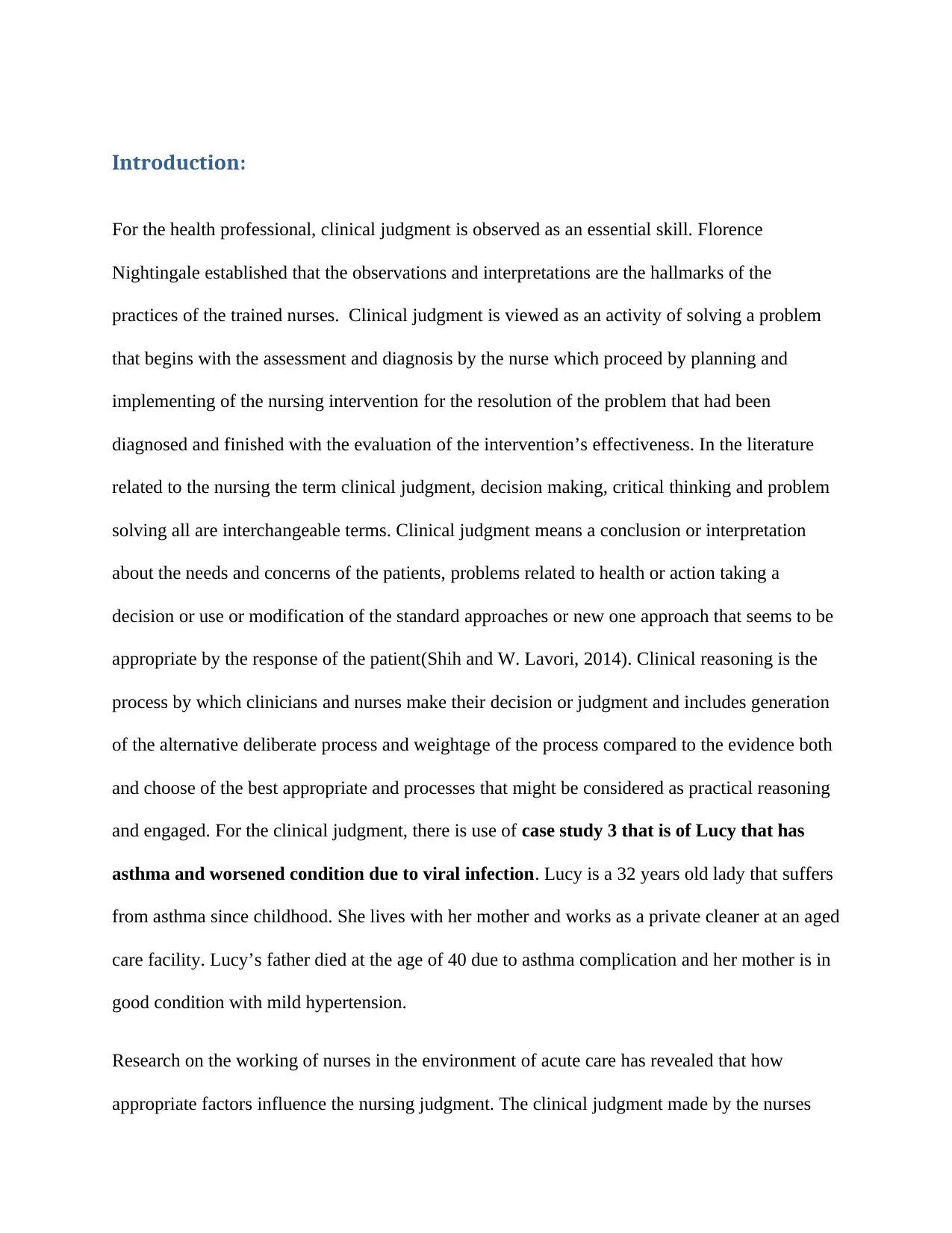
Introduction:
For the health professional, clinical judgment is observed as an essential skill. Florence
Nightingale established that the observations and interpretations are the hallmarks of the
practices of the trained nurses. Clinical judgment is viewed as an activity of solving a problem
that begins with the assessment and diagnosis by the nurse which proceed by planning and
implementing of the nursing intervention for the resolution of the problem that had been
diagnosed and finished with the evaluation of the intervention’s effectiveness. In the literature
related to the nursing the term clinical judgment, decision making, critical thinking and problem
solving all are interchangeable terms. Clinical judgment means a conclusion or interpretation
about the needs and concerns of the patients, problems related to health or action taking a
decision or use or modification of the standard approaches or new one approach that seems to be
appropriate by the response of the patient(Shih and W. Lavori, 2014). Clinical reasoning is the
process by which clinicians and nurses make their decision or judgment and includes generation
of the alternative deliberate process and weightage of the process compared to the evidence both
and choose of the best appropriate and processes that might be considered as practical reasoning
and engaged. For the clinical judgment, there is use of case study 3 that is of Lucy that has
asthma and worsened condition due to viral infection. Lucy is a 32 years old lady that suffers
from asthma since childhood. She lives with her mother and works as a private cleaner at an aged
care facility. Lucy’s father died at the age of 40 due to asthma complication and her mother is in
good condition with mild hypertension.
Research on the working of nurses in the environment of acute care has revealed that how
appropriate factors influence the nursing judgment. The clinical judgment made by the nurses
For the health professional, clinical judgment is observed as an essential skill. Florence
Nightingale established that the observations and interpretations are the hallmarks of the
practices of the trained nurses. Clinical judgment is viewed as an activity of solving a problem
that begins with the assessment and diagnosis by the nurse which proceed by planning and
implementing of the nursing intervention for the resolution of the problem that had been
diagnosed and finished with the evaluation of the intervention’s effectiveness. In the literature
related to the nursing the term clinical judgment, decision making, critical thinking and problem
solving all are interchangeable terms. Clinical judgment means a conclusion or interpretation
about the needs and concerns of the patients, problems related to health or action taking a
decision or use or modification of the standard approaches or new one approach that seems to be
appropriate by the response of the patient(Shih and W. Lavori, 2014). Clinical reasoning is the
process by which clinicians and nurses make their decision or judgment and includes generation
of the alternative deliberate process and weightage of the process compared to the evidence both
and choose of the best appropriate and processes that might be considered as practical reasoning
and engaged. For the clinical judgment, there is use of case study 3 that is of Lucy that has
asthma and worsened condition due to viral infection. Lucy is a 32 years old lady that suffers
from asthma since childhood. She lives with her mother and works as a private cleaner at an aged
care facility. Lucy’s father died at the age of 40 due to asthma complication and her mother is in
good condition with mild hypertension.
Research on the working of nurses in the environment of acute care has revealed that how
appropriate factors influence the nursing judgment. The clinical judgment made by the nurses
Paraphrase This Document
Need a fresh take? Get an instant paraphrase of this document with our AI Paraphraser
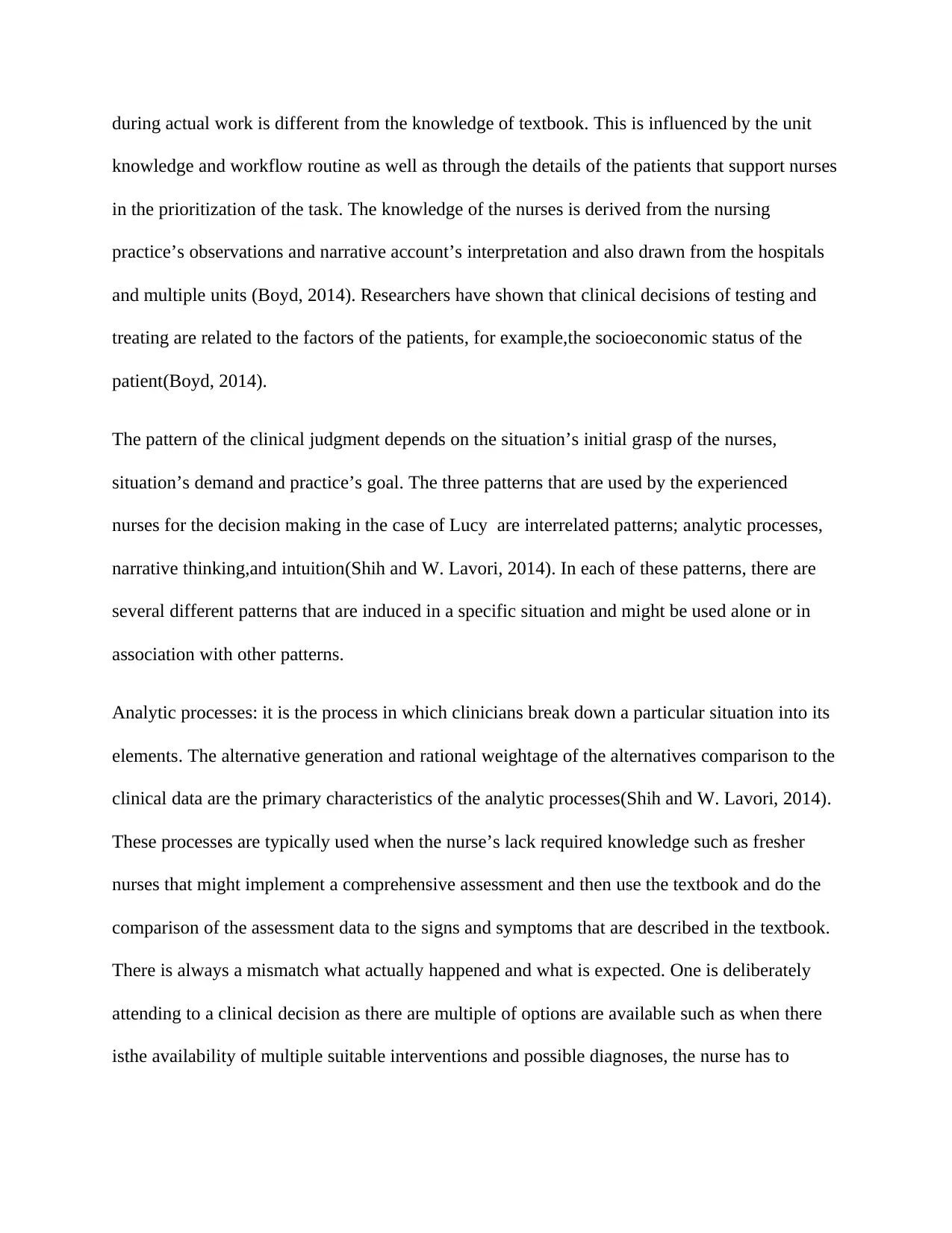
during actual work is different from the knowledge of textbook. This is influenced by the unit
knowledge and workflow routine as well as through the details of the patients that support nurses
in the prioritization of the task. The knowledge of the nurses is derived from the nursing
practice’s observations and narrative account’s interpretation and also drawn from the hospitals
and multiple units (Boyd, 2014). Researchers have shown that clinical decisions of testing and
treating are related to the factors of the patients, for example,the socioeconomic status of the
patient(Boyd, 2014).
The pattern of the clinical judgment depends on the situation’s initial grasp of the nurses,
situation’s demand and practice’s goal. The three patterns that are used by the experienced
nurses for the decision making in the case of Lucy are interrelated patterns; analytic processes,
narrative thinking,and intuition(Shih and W. Lavori, 2014). In each of these patterns, there are
several different patterns that are induced in a specific situation and might be used alone or in
association with other patterns.
Analytic processes: it is the process in which clinicians break down a particular situation into its
elements. The alternative generation and rational weightage of the alternatives comparison to the
clinical data are the primary characteristics of the analytic processes(Shih and W. Lavori, 2014).
These processes are typically used when the nurse’s lack required knowledge such as fresher
nurses that might implement a comprehensive assessment and then use the textbook and do the
comparison of the assessment data to the signs and symptoms that are described in the textbook.
There is always a mismatch what actually happened and what is expected. One is deliberately
attending to a clinical decision as there are multiple of options are available such as when there
isthe availability of multiple suitable interventions and possible diagnoses, the nurse has to
knowledge and workflow routine as well as through the details of the patients that support nurses
in the prioritization of the task. The knowledge of the nurses is derived from the nursing
practice’s observations and narrative account’s interpretation and also drawn from the hospitals
and multiple units (Boyd, 2014). Researchers have shown that clinical decisions of testing and
treating are related to the factors of the patients, for example,the socioeconomic status of the
patient(Boyd, 2014).
The pattern of the clinical judgment depends on the situation’s initial grasp of the nurses,
situation’s demand and practice’s goal. The three patterns that are used by the experienced
nurses for the decision making in the case of Lucy are interrelated patterns; analytic processes,
narrative thinking,and intuition(Shih and W. Lavori, 2014). In each of these patterns, there are
several different patterns that are induced in a specific situation and might be used alone or in
association with other patterns.
Analytic processes: it is the process in which clinicians break down a particular situation into its
elements. The alternative generation and rational weightage of the alternatives comparison to the
clinical data are the primary characteristics of the analytic processes(Shih and W. Lavori, 2014).
These processes are typically used when the nurse’s lack required knowledge such as fresher
nurses that might implement a comprehensive assessment and then use the textbook and do the
comparison of the assessment data to the signs and symptoms that are described in the textbook.
There is always a mismatch what actually happened and what is expected. One is deliberately
attending to a clinical decision as there are multiple of options are available such as when there
isthe availability of multiple suitable interventions and possible diagnoses, the nurse has to
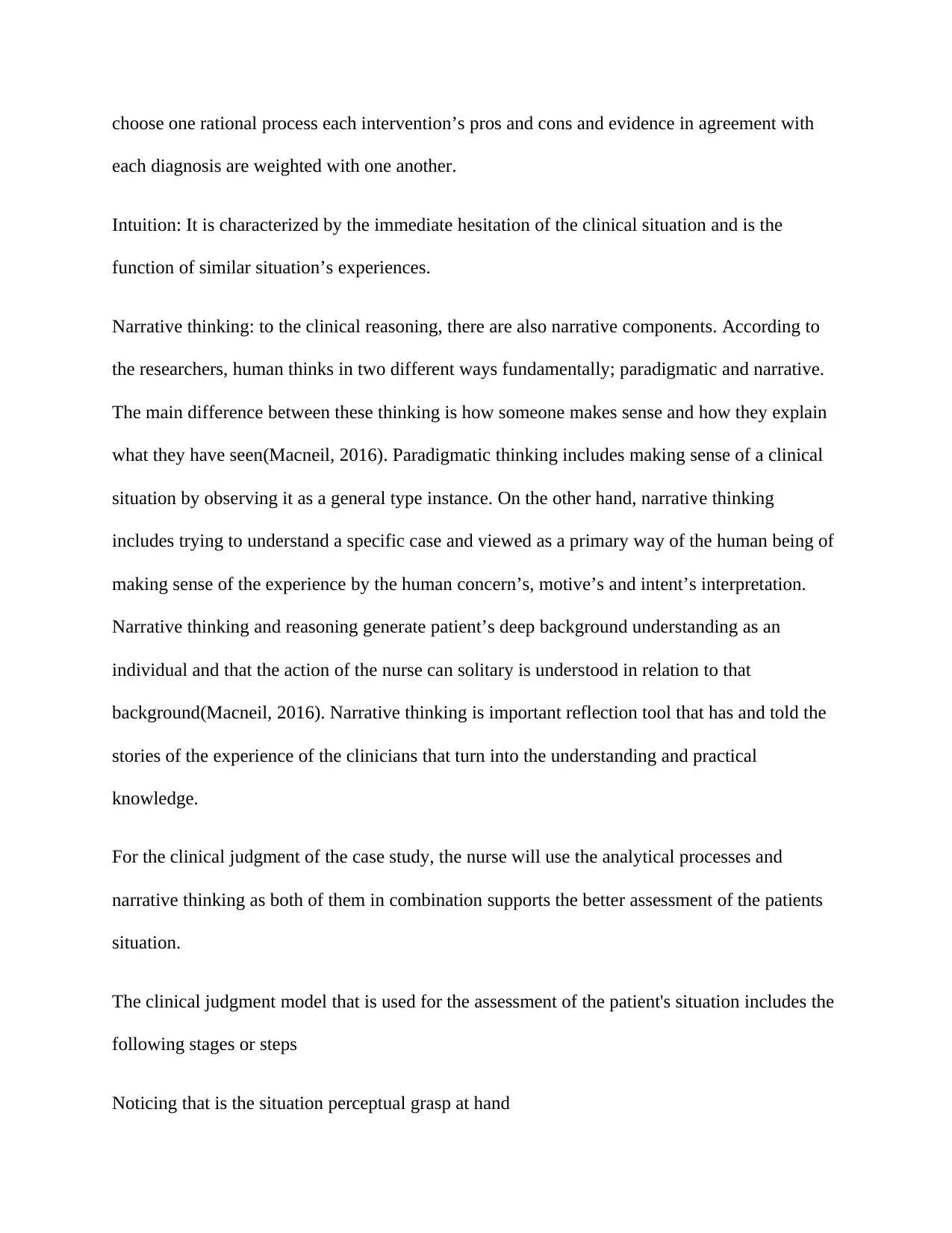
choose one rational process each intervention’s pros and cons and evidence in agreement with
each diagnosis are weighted with one another.
Intuition: It is characterized by the immediate hesitation of the clinical situation and is the
function of similar situation’s experiences.
Narrative thinking: to the clinical reasoning, there are also narrative components. According to
the researchers, human thinks in two different ways fundamentally; paradigmatic and narrative.
The main difference between these thinking is how someone makes sense and how they explain
what they have seen(Macneil, 2016). Paradigmatic thinking includes making sense of a clinical
situation by observing it as a general type instance. On the other hand, narrative thinking
includes trying to understand a specific case and viewed as a primary way of the human being of
making sense of the experience by the human concern’s, motive’s and intent’s interpretation.
Narrative thinking and reasoning generate patient’s deep background understanding as an
individual and that the action of the nurse can solitary is understood in relation to that
background(Macneil, 2016). Narrative thinking is important reflection tool that has and told the
stories of the experience of the clinicians that turn into the understanding and practical
knowledge.
For the clinical judgment of the case study, the nurse will use the analytical processes and
narrative thinking as both of them in combination supports the better assessment of the patients
situation.
The clinical judgment model that is used for the assessment of the patient's situation includes the
following stages or steps
Noticing that is the situation perceptual grasp at hand
each diagnosis are weighted with one another.
Intuition: It is characterized by the immediate hesitation of the clinical situation and is the
function of similar situation’s experiences.
Narrative thinking: to the clinical reasoning, there are also narrative components. According to
the researchers, human thinks in two different ways fundamentally; paradigmatic and narrative.
The main difference between these thinking is how someone makes sense and how they explain
what they have seen(Macneil, 2016). Paradigmatic thinking includes making sense of a clinical
situation by observing it as a general type instance. On the other hand, narrative thinking
includes trying to understand a specific case and viewed as a primary way of the human being of
making sense of the experience by the human concern’s, motive’s and intent’s interpretation.
Narrative thinking and reasoning generate patient’s deep background understanding as an
individual and that the action of the nurse can solitary is understood in relation to that
background(Macneil, 2016). Narrative thinking is important reflection tool that has and told the
stories of the experience of the clinicians that turn into the understanding and practical
knowledge.
For the clinical judgment of the case study, the nurse will use the analytical processes and
narrative thinking as both of them in combination supports the better assessment of the patients
situation.
The clinical judgment model that is used for the assessment of the patient's situation includes the
following stages or steps
Noticing that is the situation perceptual grasp at hand
⊘ This is a preview!⊘
Do you want full access?
Subscribe today to unlock all pages.

Trusted by 1+ million students worldwide
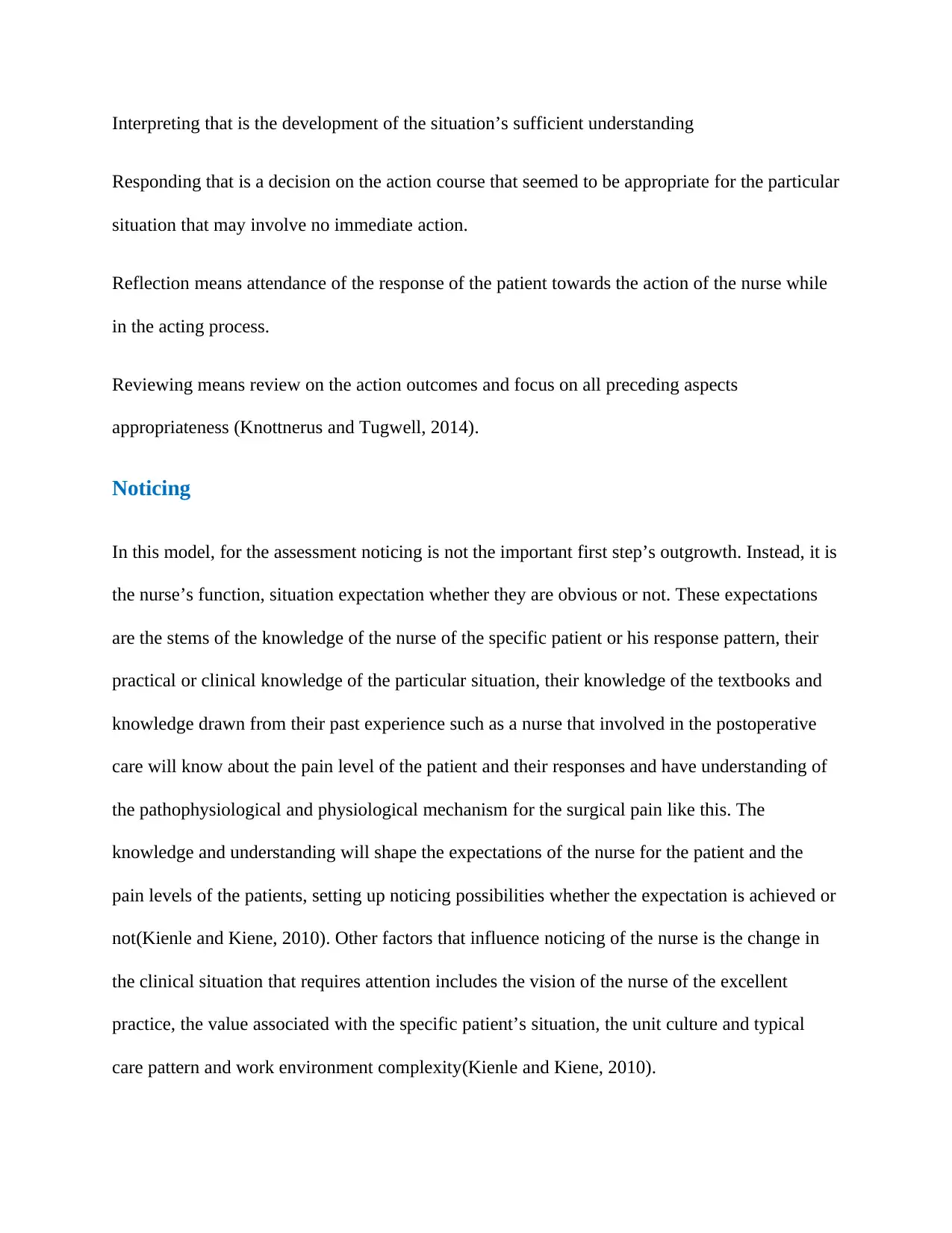
Interpreting that is the development of the situation’s sufficient understanding
Responding that is a decision on the action course that seemed to be appropriate for the particular
situation that may involve no immediate action.
Reflection means attendance of the response of the patient towards the action of the nurse while
in the acting process.
Reviewing means review on the action outcomes and focus on all preceding aspects
appropriateness (Knottnerus and Tugwell, 2014).
Noticing
In this model, for the assessment noticing is not the important first step’s outgrowth. Instead, it is
the nurse’s function, situation expectation whether they are obvious or not. These expectations
are the stems of the knowledge of the nurse of the specific patient or his response pattern, their
practical or clinical knowledge of the particular situation, their knowledge of the textbooks and
knowledge drawn from their past experience such as a nurse that involved in the postoperative
care will know about the pain level of the patient and their responses and have understanding of
the pathophysiological and physiological mechanism for the surgical pain like this. The
knowledge and understanding will shape the expectations of the nurse for the patient and the
pain levels of the patients, setting up noticing possibilities whether the expectation is achieved or
not(Kienle and Kiene, 2010). Other factors that influence noticing of the nurse is the change in
the clinical situation that requires attention includes the vision of the nurse of the excellent
practice, the value associated with the specific patient’s situation, the unit culture and typical
care pattern and work environment complexity(Kienle and Kiene, 2010).
Responding that is a decision on the action course that seemed to be appropriate for the particular
situation that may involve no immediate action.
Reflection means attendance of the response of the patient towards the action of the nurse while
in the acting process.
Reviewing means review on the action outcomes and focus on all preceding aspects
appropriateness (Knottnerus and Tugwell, 2014).
Noticing
In this model, for the assessment noticing is not the important first step’s outgrowth. Instead, it is
the nurse’s function, situation expectation whether they are obvious or not. These expectations
are the stems of the knowledge of the nurse of the specific patient or his response pattern, their
practical or clinical knowledge of the particular situation, their knowledge of the textbooks and
knowledge drawn from their past experience such as a nurse that involved in the postoperative
care will know about the pain level of the patient and their responses and have understanding of
the pathophysiological and physiological mechanism for the surgical pain like this. The
knowledge and understanding will shape the expectations of the nurse for the patient and the
pain levels of the patients, setting up noticing possibilities whether the expectation is achieved or
not(Kienle and Kiene, 2010). Other factors that influence noticing of the nurse is the change in
the clinical situation that requires attention includes the vision of the nurse of the excellent
practice, the value associated with the specific patient’s situation, the unit culture and typical
care pattern and work environment complexity(Kienle and Kiene, 2010).
Paraphrase This Document
Need a fresh take? Get an instant paraphrase of this document with our AI Paraphraser
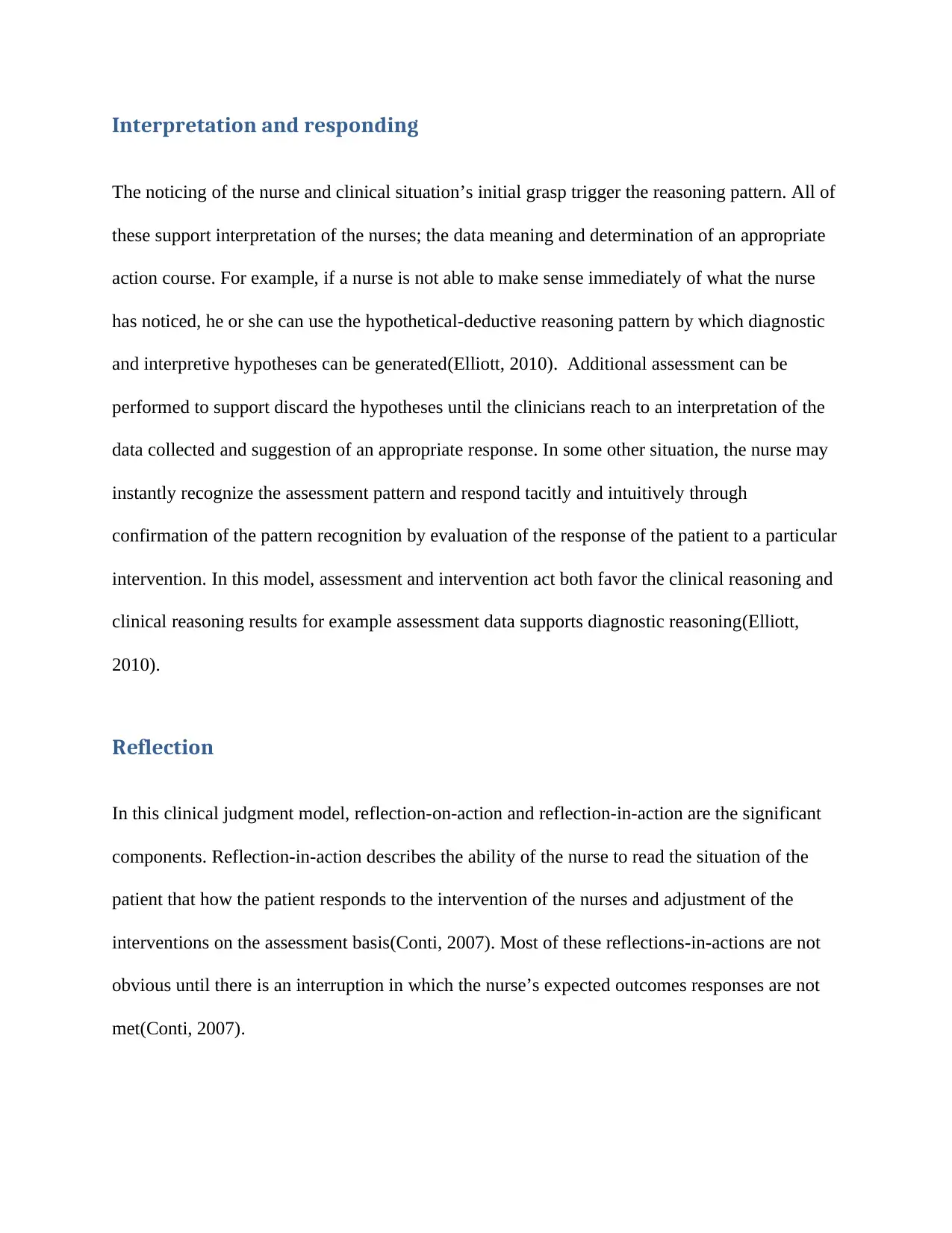
Interpretation and responding
The noticing of the nurse and clinical situation’s initial grasp trigger the reasoning pattern. All of
these support interpretation of the nurses; the data meaning and determination of an appropriate
action course. For example, if a nurse is not able to make sense immediately of what the nurse
has noticed, he or she can use the hypothetical-deductive reasoning pattern by which diagnostic
and interpretive hypotheses can be generated(Elliott, 2010). Additional assessment can be
performed to support discard the hypotheses until the clinicians reach to an interpretation of the
data collected and suggestion of an appropriate response. In some other situation, the nurse may
instantly recognize the assessment pattern and respond tacitly and intuitively through
confirmation of the pattern recognition by evaluation of the response of the patient to a particular
intervention. In this model, assessment and intervention act both favor the clinical reasoning and
clinical reasoning results for example assessment data supports diagnostic reasoning(Elliott,
2010).
Reflection
In this clinical judgment model, reflection-on-action and reflection-in-action are the significant
components. Reflection-in-action describes the ability of the nurse to read the situation of the
patient that how the patient responds to the intervention of the nurses and adjustment of the
interventions on the assessment basis(Conti, 2007). Most of these reflections-in-actions are not
obvious until there is an interruption in which the nurse’s expected outcomes responses are not
met(Conti, 2007).
The noticing of the nurse and clinical situation’s initial grasp trigger the reasoning pattern. All of
these support interpretation of the nurses; the data meaning and determination of an appropriate
action course. For example, if a nurse is not able to make sense immediately of what the nurse
has noticed, he or she can use the hypothetical-deductive reasoning pattern by which diagnostic
and interpretive hypotheses can be generated(Elliott, 2010). Additional assessment can be
performed to support discard the hypotheses until the clinicians reach to an interpretation of the
data collected and suggestion of an appropriate response. In some other situation, the nurse may
instantly recognize the assessment pattern and respond tacitly and intuitively through
confirmation of the pattern recognition by evaluation of the response of the patient to a particular
intervention. In this model, assessment and intervention act both favor the clinical reasoning and
clinical reasoning results for example assessment data supports diagnostic reasoning(Elliott,
2010).
Reflection
In this clinical judgment model, reflection-on-action and reflection-in-action are the significant
components. Reflection-in-action describes the ability of the nurse to read the situation of the
patient that how the patient responds to the intervention of the nurses and adjustment of the
interventions on the assessment basis(Conti, 2007). Most of these reflections-in-actions are not
obvious until there is an interruption in which the nurse’s expected outcomes responses are not
met(Conti, 2007).
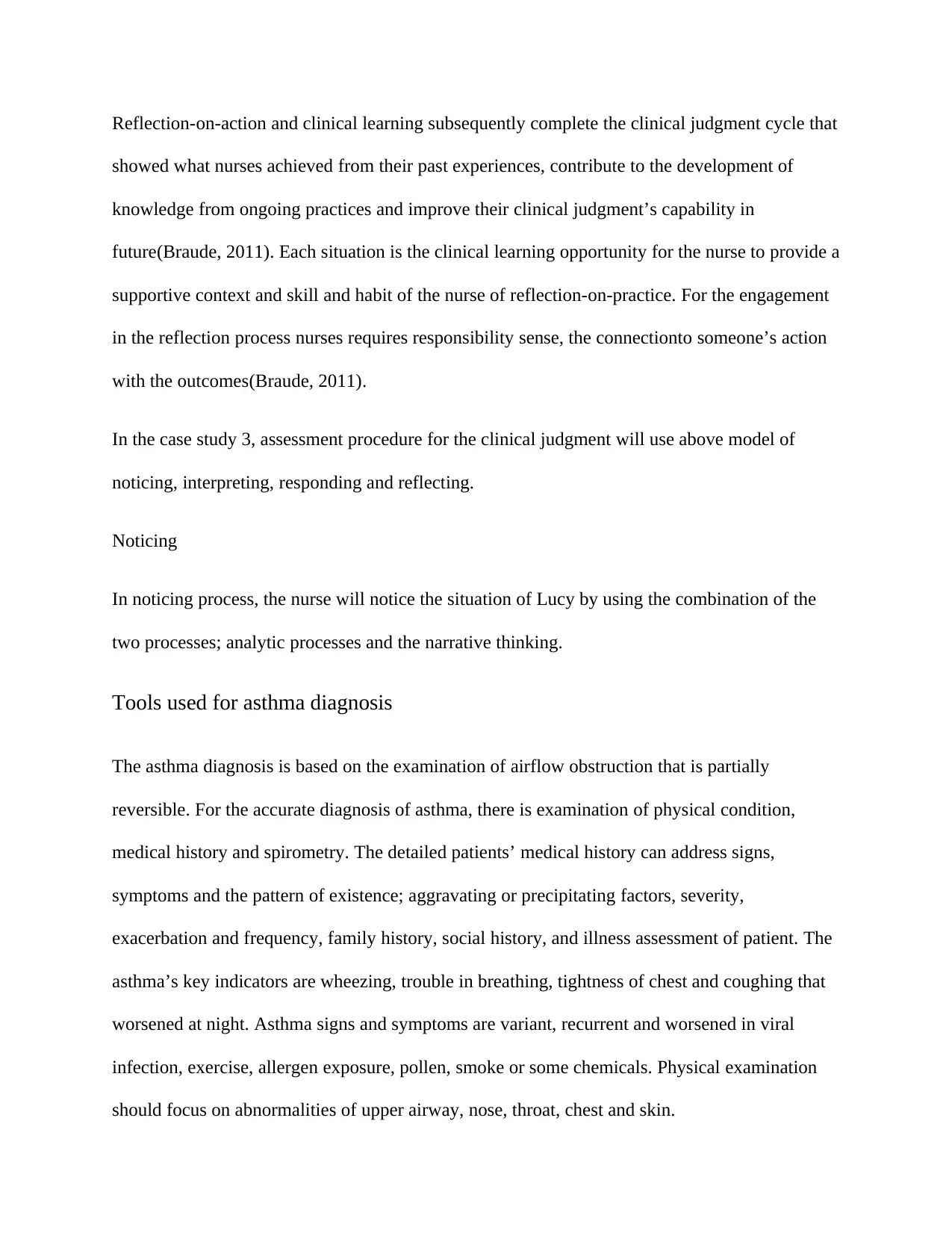
Reflection-on-action and clinical learning subsequently complete the clinical judgment cycle that
showed what nurses achieved from their past experiences, contribute to the development of
knowledge from ongoing practices and improve their clinical judgment’s capability in
future(Braude, 2011). Each situation is the clinical learning opportunity for the nurse to provide a
supportive context and skill and habit of the nurse of reflection-on-practice. For the engagement
in the reflection process nurses requires responsibility sense, the connectionto someone’s action
with the outcomes(Braude, 2011).
In the case study 3, assessment procedure for the clinical judgment will use above model of
noticing, interpreting, responding and reflecting.
Noticing
In noticing process, the nurse will notice the situation of Lucy by using the combination of the
two processes; analytic processes and the narrative thinking.
Tools used for asthma diagnosis
The asthma diagnosis is based on the examination of airflow obstruction that is partially
reversible. For the accurate diagnosis of asthma, there is examination of physical condition,
medical history and spirometry. The detailed patients’ medical history can address signs,
symptoms and the pattern of existence; aggravating or precipitating factors, severity,
exacerbation and frequency, family history, social history, and illness assessment of patient. The
asthma’s key indicators are wheezing, trouble in breathing, tightness of chest and coughing that
worsened at night. Asthma signs and symptoms are variant, recurrent and worsened in viral
infection, exercise, allergen exposure, pollen, smoke or some chemicals. Physical examination
should focus on abnormalities of upper airway, nose, throat, chest and skin.
showed what nurses achieved from their past experiences, contribute to the development of
knowledge from ongoing practices and improve their clinical judgment’s capability in
future(Braude, 2011). Each situation is the clinical learning opportunity for the nurse to provide a
supportive context and skill and habit of the nurse of reflection-on-practice. For the engagement
in the reflection process nurses requires responsibility sense, the connectionto someone’s action
with the outcomes(Braude, 2011).
In the case study 3, assessment procedure for the clinical judgment will use above model of
noticing, interpreting, responding and reflecting.
Noticing
In noticing process, the nurse will notice the situation of Lucy by using the combination of the
two processes; analytic processes and the narrative thinking.
Tools used for asthma diagnosis
The asthma diagnosis is based on the examination of airflow obstruction that is partially
reversible. For the accurate diagnosis of asthma, there is examination of physical condition,
medical history and spirometry. The detailed patients’ medical history can address signs,
symptoms and the pattern of existence; aggravating or precipitating factors, severity,
exacerbation and frequency, family history, social history, and illness assessment of patient. The
asthma’s key indicators are wheezing, trouble in breathing, tightness of chest and coughing that
worsened at night. Asthma signs and symptoms are variant, recurrent and worsened in viral
infection, exercise, allergen exposure, pollen, smoke or some chemicals. Physical examination
should focus on abnormalities of upper airway, nose, throat, chest and skin.
⊘ This is a preview!⊘
Do you want full access?
Subscribe today to unlock all pages.

Trusted by 1+ million students worldwide
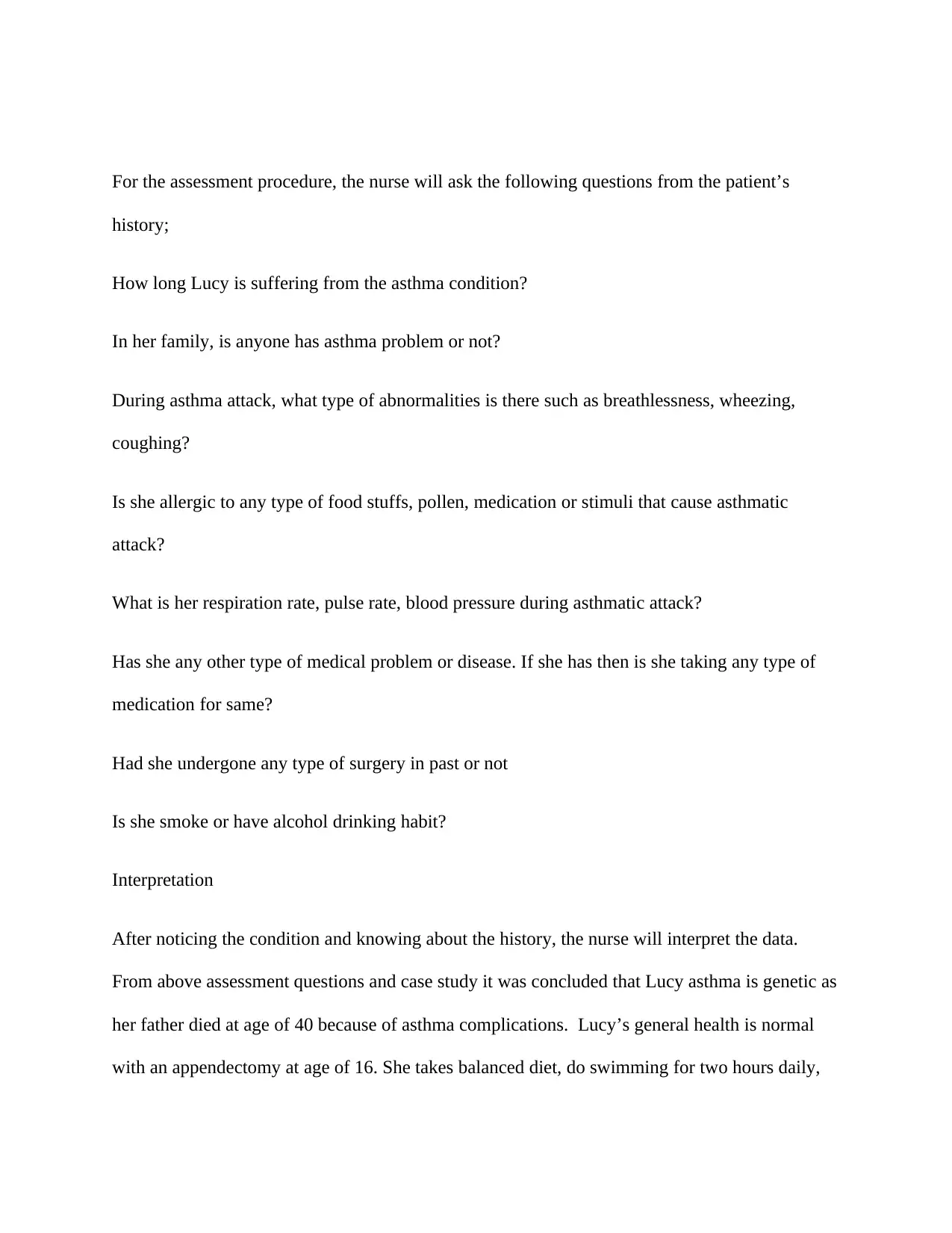
For the assessment procedure, the nurse will ask the following questions from the patient’s
history;
How long Lucy is suffering from the asthma condition?
In her family, is anyone has asthma problem or not?
During asthma attack, what type of abnormalities is there such as breathlessness, wheezing,
coughing?
Is she allergic to any type of food stuffs, pollen, medication or stimuli that cause asthmatic
attack?
What is her respiration rate, pulse rate, blood pressure during asthmatic attack?
Has she any other type of medical problem or disease. If she has then is she taking any type of
medication for same?
Had she undergone any type of surgery in past or not
Is she smoke or have alcohol drinking habit?
Interpretation
After noticing the condition and knowing about the history, the nurse will interpret the data.
From above assessment questions and case study it was concluded that Lucy asthma is genetic as
her father died at age of 40 because of asthma complications. Lucy’s general health is normal
with an appendectomy at age of 16. She takes balanced diet, do swimming for two hours daily,
history;
How long Lucy is suffering from the asthma condition?
In her family, is anyone has asthma problem or not?
During asthma attack, what type of abnormalities is there such as breathlessness, wheezing,
coughing?
Is she allergic to any type of food stuffs, pollen, medication or stimuli that cause asthmatic
attack?
What is her respiration rate, pulse rate, blood pressure during asthmatic attack?
Has she any other type of medical problem or disease. If she has then is she taking any type of
medication for same?
Had she undergone any type of surgery in past or not
Is she smoke or have alcohol drinking habit?
Interpretation
After noticing the condition and knowing about the history, the nurse will interpret the data.
From above assessment questions and case study it was concluded that Lucy asthma is genetic as
her father died at age of 40 because of asthma complications. Lucy’s general health is normal
with an appendectomy at age of 16. She takes balanced diet, do swimming for two hours daily,
Paraphrase This Document
Need a fresh take? Get an instant paraphrase of this document with our AI Paraphraser
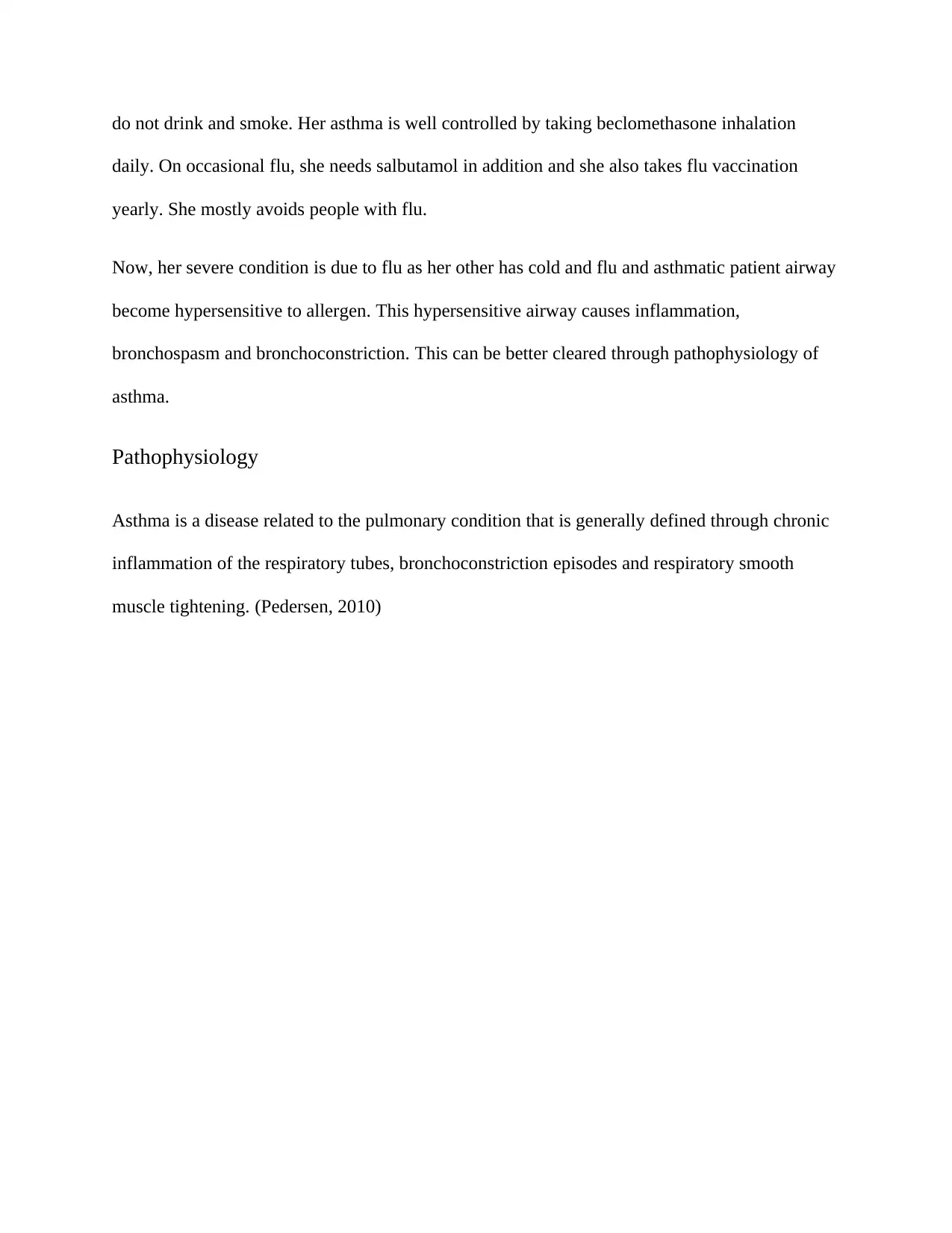
do not drink and smoke. Her asthma is well controlled by taking beclomethasone inhalation
daily. On occasional flu, she needs salbutamol in addition and she also takes flu vaccination
yearly. She mostly avoids people with flu.
Now, her severe condition is due to flu as her other has cold and flu and asthmatic patient airway
become hypersensitive to allergen. This hypersensitive airway causes inflammation,
bronchospasm and bronchoconstriction. This can be better cleared through pathophysiology of
asthma.
Pathophysiology
Asthma is a disease related to the pulmonary condition that is generally defined through chronic
inflammation of the respiratory tubes, bronchoconstriction episodes and respiratory smooth
muscle tightening. (Pedersen, 2010)
daily. On occasional flu, she needs salbutamol in addition and she also takes flu vaccination
yearly. She mostly avoids people with flu.
Now, her severe condition is due to flu as her other has cold and flu and asthmatic patient airway
become hypersensitive to allergen. This hypersensitive airway causes inflammation,
bronchospasm and bronchoconstriction. This can be better cleared through pathophysiology of
asthma.
Pathophysiology
Asthma is a disease related to the pulmonary condition that is generally defined through chronic
inflammation of the respiratory tubes, bronchoconstriction episodes and respiratory smooth
muscle tightening. (Pedersen, 2010)
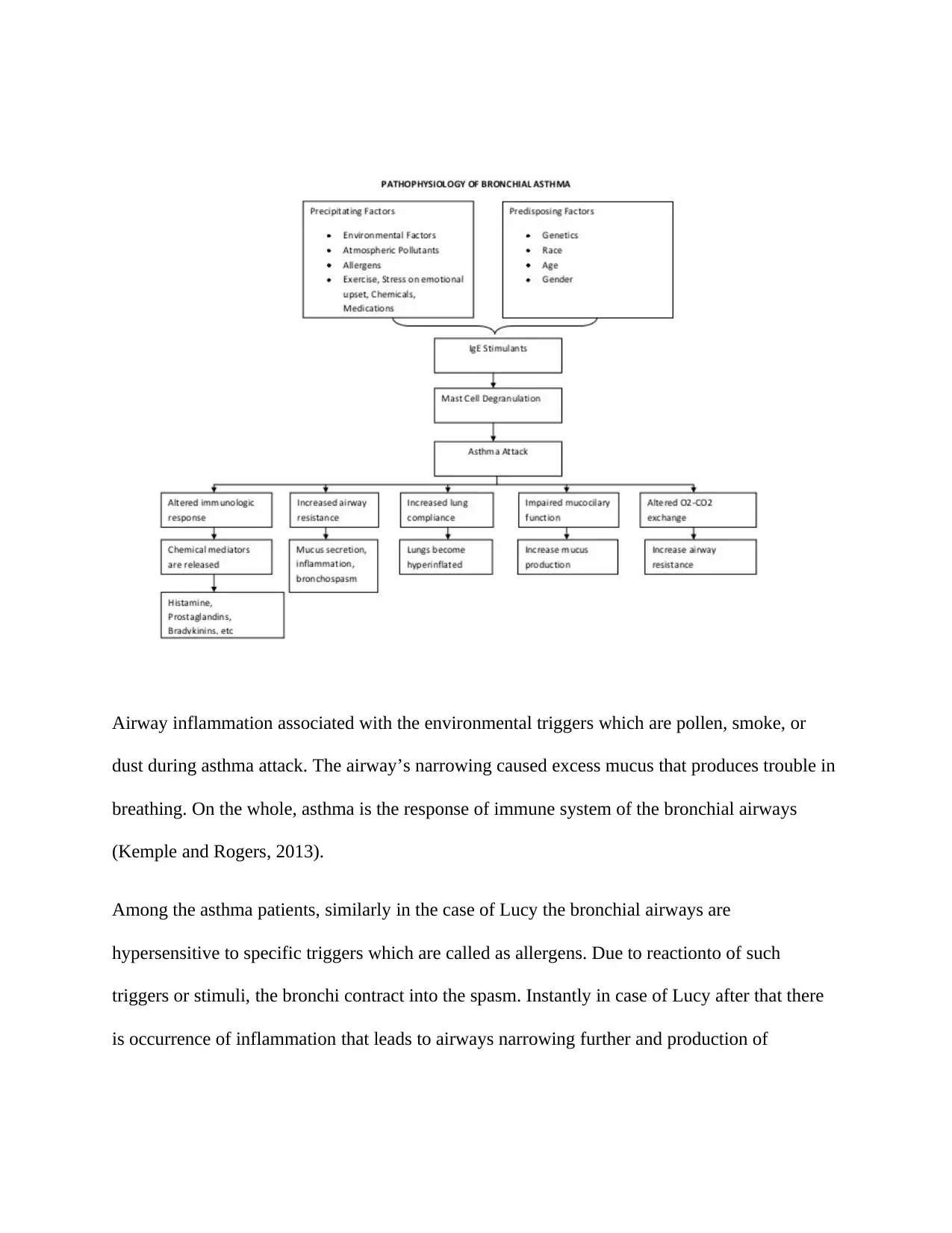
Airway inflammation associated with the environmental triggers which are pollen, smoke, or
dust during asthma attack. The airway’s narrowing caused excess mucus that produces trouble in
breathing. On the whole, asthma is the response of immune system of the bronchial airways
(Kemple and Rogers, 2013).
Among the asthma patients, similarly in the case of Lucy the bronchial airways are
hypersensitive to specific triggers which are called as allergens. Due to reactionto of such
triggers or stimuli, the bronchi contract into the spasm. Instantly in case of Lucy after that there
is occurrence of inflammation that leads to airways narrowing further and production of
dust during asthma attack. The airway’s narrowing caused excess mucus that produces trouble in
breathing. On the whole, asthma is the response of immune system of the bronchial airways
(Kemple and Rogers, 2013).
Among the asthma patients, similarly in the case of Lucy the bronchial airways are
hypersensitive to specific triggers which are called as allergens. Due to reactionto of such
triggers or stimuli, the bronchi contract into the spasm. Instantly in case of Lucy after that there
is occurrence of inflammation that leads to airways narrowing further and production of
⊘ This is a preview!⊘
Do you want full access?
Subscribe today to unlock all pages.

Trusted by 1+ million students worldwide
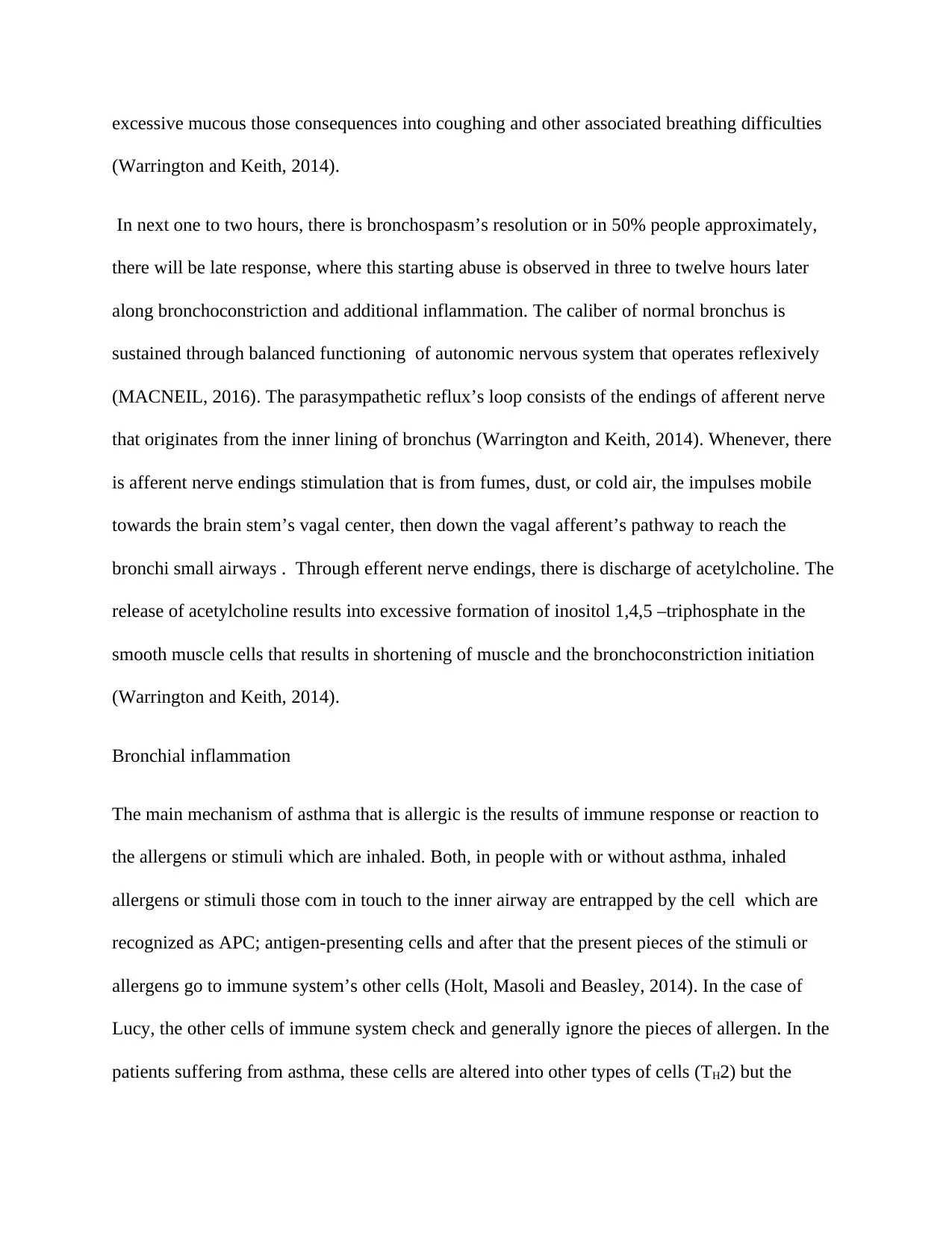
excessive mucous those consequences into coughing and other associated breathing difficulties
(Warrington and Keith, 2014).
In next one to two hours, there is bronchospasm’s resolution or in 50% people approximately,
there will be late response, where this starting abuse is observed in three to twelve hours later
along bronchoconstriction and additional inflammation. The caliber of normal bronchus is
sustained through balanced functioning of autonomic nervous system that operates reflexively
(MACNEIL, 2016). The parasympathetic reflux’s loop consists of the endings of afferent nerve
that originates from the inner lining of bronchus (Warrington and Keith, 2014). Whenever, there
is afferent nerve endings stimulation that is from fumes, dust, or cold air, the impulses mobile
towards the brain stem’s vagal center, then down the vagal afferent’s pathway to reach the
bronchi small airways . Through efferent nerve endings, there is discharge of acetylcholine. The
release of acetylcholine results into excessive formation of inositol 1,4,5 –triphosphate in the
smooth muscle cells that results in shortening of muscle and the bronchoconstriction initiation
(Warrington and Keith, 2014).
Bronchial inflammation
The main mechanism of asthma that is allergic is the results of immune response or reaction to
the allergens or stimuli which are inhaled. Both, in people with or without asthma, inhaled
allergens or stimuli those com in touch to the inner airway are entrapped by the cell which are
recognized as APC; antigen-presenting cells and after that the present pieces of the stimuli or
allergens go to immune system’s other cells (Holt, Masoli and Beasley, 2014). In the case of
Lucy, the other cells of immune system check and generally ignore the pieces of allergen. In the
patients suffering from asthma, these cells are altered into other types of cells (TH2) but the
(Warrington and Keith, 2014).
In next one to two hours, there is bronchospasm’s resolution or in 50% people approximately,
there will be late response, where this starting abuse is observed in three to twelve hours later
along bronchoconstriction and additional inflammation. The caliber of normal bronchus is
sustained through balanced functioning of autonomic nervous system that operates reflexively
(MACNEIL, 2016). The parasympathetic reflux’s loop consists of the endings of afferent nerve
that originates from the inner lining of bronchus (Warrington and Keith, 2014). Whenever, there
is afferent nerve endings stimulation that is from fumes, dust, or cold air, the impulses mobile
towards the brain stem’s vagal center, then down the vagal afferent’s pathway to reach the
bronchi small airways . Through efferent nerve endings, there is discharge of acetylcholine. The
release of acetylcholine results into excessive formation of inositol 1,4,5 –triphosphate in the
smooth muscle cells that results in shortening of muscle and the bronchoconstriction initiation
(Warrington and Keith, 2014).
Bronchial inflammation
The main mechanism of asthma that is allergic is the results of immune response or reaction to
the allergens or stimuli which are inhaled. Both, in people with or without asthma, inhaled
allergens or stimuli those com in touch to the inner airway are entrapped by the cell which are
recognized as APC; antigen-presenting cells and after that the present pieces of the stimuli or
allergens go to immune system’s other cells (Holt, Masoli and Beasley, 2014). In the case of
Lucy, the other cells of immune system check and generally ignore the pieces of allergen. In the
patients suffering from asthma, these cells are altered into other types of cells (TH2) but the
Paraphrase This Document
Need a fresh take? Get an instant paraphrase of this document with our AI Paraphraser
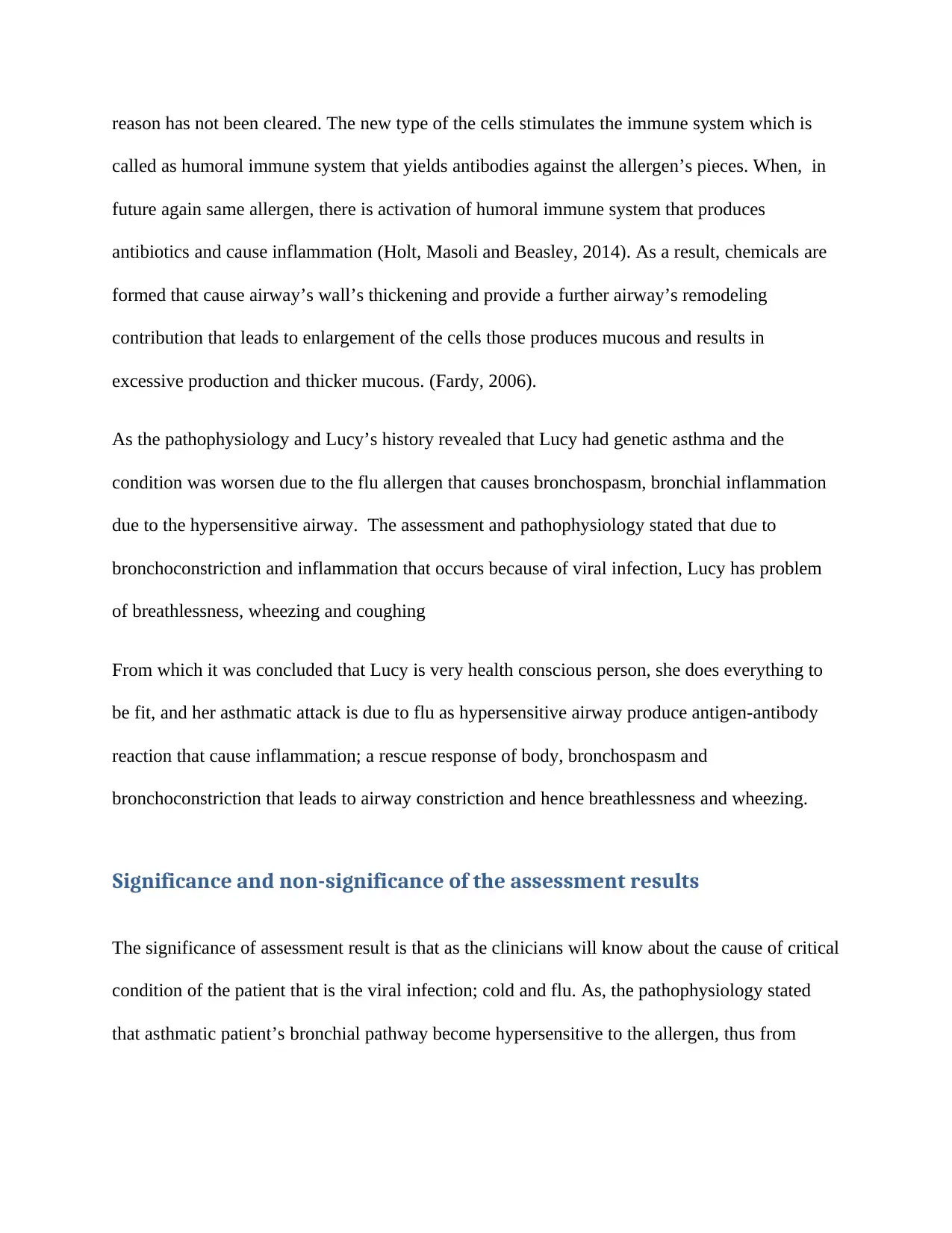
reason has not been cleared. The new type of the cells stimulates the immune system which is
called as humoral immune system that yields antibodies against the allergen’s pieces. When, in
future again same allergen, there is activation of humoral immune system that produces
antibiotics and cause inflammation (Holt, Masoli and Beasley, 2014). As a result, chemicals are
formed that cause airway’s wall’s thickening and provide a further airway’s remodeling
contribution that leads to enlargement of the cells those produces mucous and results in
excessive production and thicker mucous. (Fardy, 2006).
As the pathophysiology and Lucy’s history revealed that Lucy had genetic asthma and the
condition was worsen due to the flu allergen that causes bronchospasm, bronchial inflammation
due to the hypersensitive airway. The assessment and pathophysiology stated that due to
bronchoconstriction and inflammation that occurs because of viral infection, Lucy has problem
of breathlessness, wheezing and coughing
From which it was concluded that Lucy is very health conscious person, she does everything to
be fit, and her asthmatic attack is due to flu as hypersensitive airway produce antigen-antibody
reaction that cause inflammation; a rescue response of body, bronchospasm and
bronchoconstriction that leads to airway constriction and hence breathlessness and wheezing.
Significance and non-significance of the assessment results
The significance of assessment result is that as the clinicians will know about the cause of critical
condition of the patient that is the viral infection; cold and flu. As, the pathophysiology stated
that asthmatic patient’s bronchial pathway become hypersensitive to the allergen, thus from
called as humoral immune system that yields antibodies against the allergen’s pieces. When, in
future again same allergen, there is activation of humoral immune system that produces
antibiotics and cause inflammation (Holt, Masoli and Beasley, 2014). As a result, chemicals are
formed that cause airway’s wall’s thickening and provide a further airway’s remodeling
contribution that leads to enlargement of the cells those produces mucous and results in
excessive production and thicker mucous. (Fardy, 2006).
As the pathophysiology and Lucy’s history revealed that Lucy had genetic asthma and the
condition was worsen due to the flu allergen that causes bronchospasm, bronchial inflammation
due to the hypersensitive airway. The assessment and pathophysiology stated that due to
bronchoconstriction and inflammation that occurs because of viral infection, Lucy has problem
of breathlessness, wheezing and coughing
From which it was concluded that Lucy is very health conscious person, she does everything to
be fit, and her asthmatic attack is due to flu as hypersensitive airway produce antigen-antibody
reaction that cause inflammation; a rescue response of body, bronchospasm and
bronchoconstriction that leads to airway constriction and hence breathlessness and wheezing.
Significance and non-significance of the assessment results
The significance of assessment result is that as the clinicians will know about the cause of critical
condition of the patient that is the viral infection; cold and flu. As, the pathophysiology stated
that asthmatic patient’s bronchial pathway become hypersensitive to the allergen, thus from
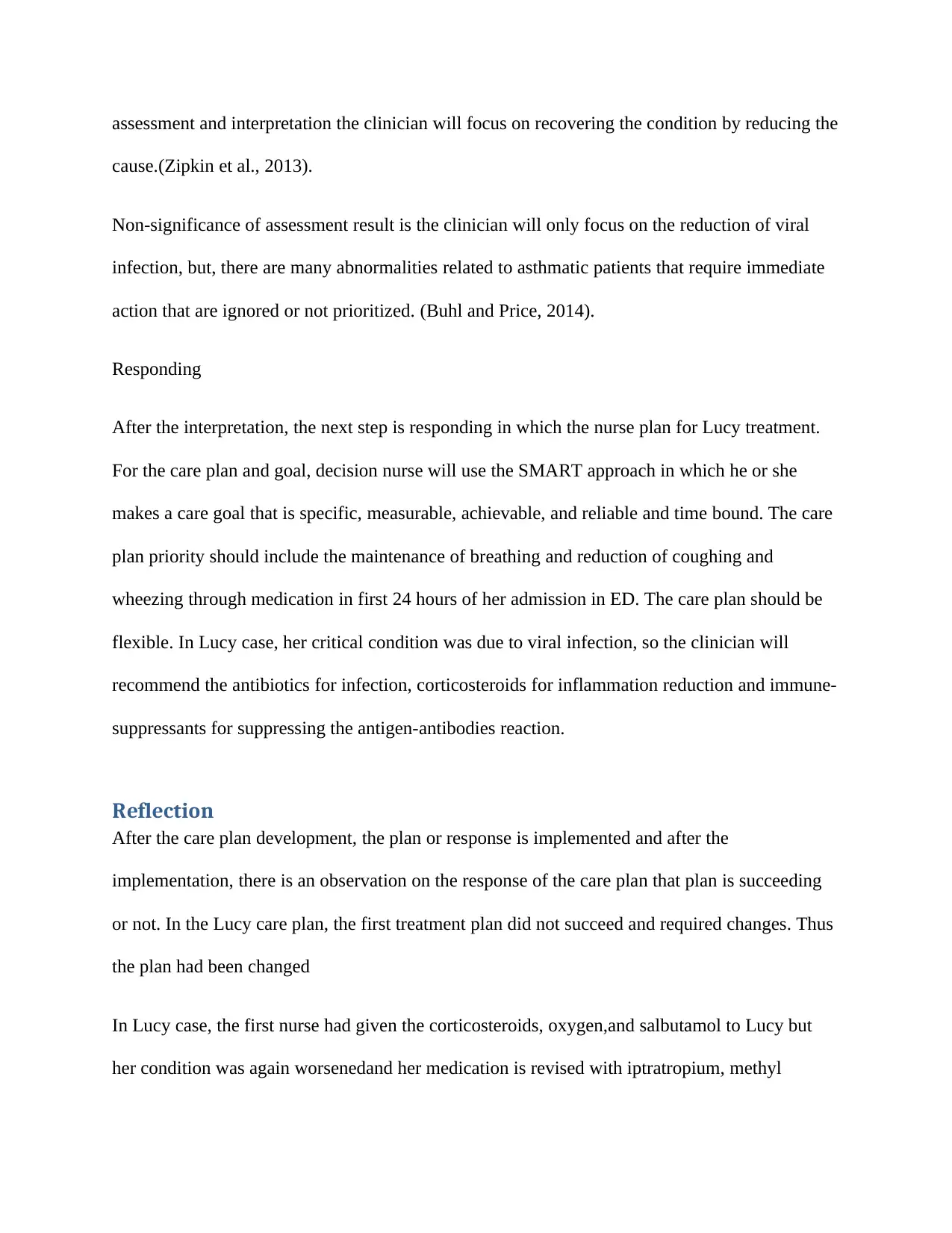
assessment and interpretation the clinician will focus on recovering the condition by reducing the
cause.(Zipkin et al., 2013).
Non-significance of assessment result is the clinician will only focus on the reduction of viral
infection, but, there are many abnormalities related to asthmatic patients that require immediate
action that are ignored or not prioritized. (Buhl and Price, 2014).
Responding
After the interpretation, the next step is responding in which the nurse plan for Lucy treatment.
For the care plan and goal, decision nurse will use the SMART approach in which he or she
makes a care goal that is specific, measurable, achievable, and reliable and time bound. The care
plan priority should include the maintenance of breathing and reduction of coughing and
wheezing through medication in first 24 hours of her admission in ED. The care plan should be
flexible. In Lucy case, her critical condition was due to viral infection, so the clinician will
recommend the antibiotics for infection, corticosteroids for inflammation reduction and immune-
suppressants for suppressing the antigen-antibodies reaction.
Reflection
After the care plan development, the plan or response is implemented and after the
implementation, there is an observation on the response of the care plan that plan is succeeding
or not. In the Lucy care plan, the first treatment plan did not succeed and required changes. Thus
the plan had been changed
In Lucy case, the first nurse had given the corticosteroids, oxygen,and salbutamol to Lucy but
her condition was again worsenedand her medication is revised with iptratropium, methyl
cause.(Zipkin et al., 2013).
Non-significance of assessment result is the clinician will only focus on the reduction of viral
infection, but, there are many abnormalities related to asthmatic patients that require immediate
action that are ignored or not prioritized. (Buhl and Price, 2014).
Responding
After the interpretation, the next step is responding in which the nurse plan for Lucy treatment.
For the care plan and goal, decision nurse will use the SMART approach in which he or she
makes a care goal that is specific, measurable, achievable, and reliable and time bound. The care
plan priority should include the maintenance of breathing and reduction of coughing and
wheezing through medication in first 24 hours of her admission in ED. The care plan should be
flexible. In Lucy case, her critical condition was due to viral infection, so the clinician will
recommend the antibiotics for infection, corticosteroids for inflammation reduction and immune-
suppressants for suppressing the antigen-antibodies reaction.
Reflection
After the care plan development, the plan or response is implemented and after the
implementation, there is an observation on the response of the care plan that plan is succeeding
or not. In the Lucy care plan, the first treatment plan did not succeed and required changes. Thus
the plan had been changed
In Lucy case, the first nurse had given the corticosteroids, oxygen,and salbutamol to Lucy but
her condition was again worsenedand her medication is revised with iptratropium, methyl
⊘ This is a preview!⊘
Do you want full access?
Subscribe today to unlock all pages.

Trusted by 1+ million students worldwide
1 out of 15
Related Documents
Your All-in-One AI-Powered Toolkit for Academic Success.
+13062052269
info@desklib.com
Available 24*7 on WhatsApp / Email
![[object Object]](/_next/static/media/star-bottom.7253800d.svg)
Unlock your academic potential
Copyright © 2020–2025 A2Z Services. All Rights Reserved. Developed and managed by ZUCOL.





